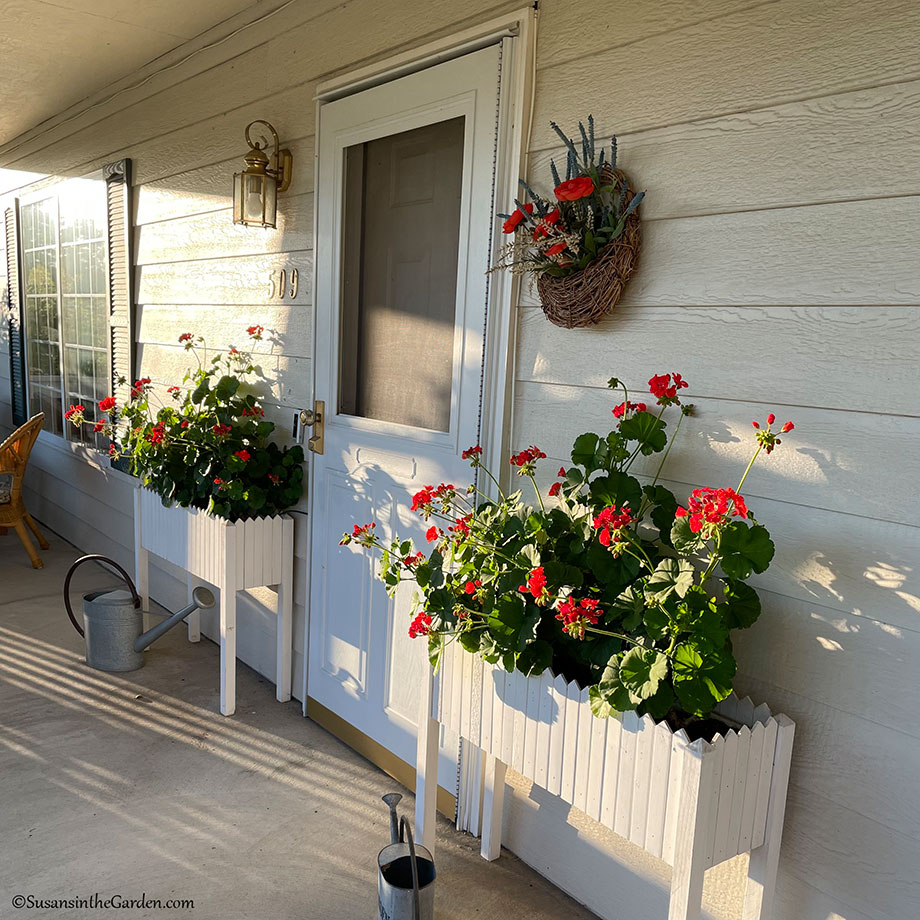Sept. 4 Column: Overwintering Geraniums

I know we gardeners don’t want to think about the end of the growing season yet, but it’s important to plan ahead. For today’s garden column, I decided to write about overwintering geraniums. This is something that is so easy and it’s a great way to save money. You can read my column in The Spokesman-Review: Don’t toss those geraniums at the end of the season. Box them up for next year. Or you can read my column underneath the video below.
I have been overwintering geraniums (technically known as Pelargoniums) since 2014. Prior to that, I always tossed them in the compost pile at the end of the season but that was such a waste of my gardening dollars. I did some research and discovered it’s not hard to overwinter them… and I’ve been doing this ever since! In 2014, I shot my first video on the technique. Would you believe it has been viewed over 435,000 times?! That is crazy. I’ve since shot other videos about it but everyone seems to love that first one. I’ve embedded it under this week’s video.
Speaking of which, my new video is about late summer gardening tasks. This covers both vegetable and ornamental plants, in case you’re wondering. I discuss important things to do now:
And here’s my first video on overwintering geraniums. Yup, it’s a blast from the past!
Here is my garden column:
by Susan Mulvihill
Do you grow annual geraniums? Do you like saving money? I want to share a tip with you before we get our first frost.
I’ve grown geraniums, technically known as pelargoniums, in containers for years. Up until several years ago, I always tossed them into the compost pile at the end of the growing season and purchased new plants the following spring.
In 2014, I decided it was high time I learned how to overwinter them. After some research, I shot a video on the process and quickly discovered there were a lot of gardeners who also wanted to know how to do this. That video has been viewed over 435,000 times. I’ve shot a total of seven videos on this topic over the years, and they have been viewed over 1 million times.
If you haven’t seen them, allow me to introduce you to this simple, money-saving technique. I should add that the process won’t sound like it should work, yet it does year after year.
Before the frosts arrive, dig up your annual geraniums. Knock the soil off the roots and snip off any flowers or flower buds. If the soil was damp, allow the plants’ roots to dry off for a few hours before proceeding to the next step.
Grab a cardboard box that is large enough to accommodate your prepared plants. As I’m stacking them inside the box, I typically alternate the direction each one faces. For example, I place a plant with its roots pointing to the right, then lay the next plant with its roots pointing left.
Next, loosely fold the box flaps together but do not tape the box shut because the goal is to have a bit of air circulation. Store the box in a dark location where the temperature stays around 50 degrees F. I put them in my basement for the winter.
Once a month, take a peek at the plants to make sure nothing is molding or rotting. Don’t be alarmed when you see shriveled leaves because that is exactly what will happen over the course of a few months. If the main stems of the plants look particularly shriveled up, you can give them a very light spritz of water but it’s risky to introduce much moisture onto the plants. To be honest, I’ve never had to do this.
In early February, it’s time to pot up your plants. I have to warn you: they will look awful! Remove the dead leaves and any flowers that bloomed during the winter. I know that sounds crazy but it does happen and always amazes me. Use a lightly-moistened potting mix and place the pots near a bright window.
You’ll soon see new leaves emerging. That’s when you should give each plant a light feeding with a liquid nitrogen fertilizer such as fish emulsion. Once the plants have grown several leaves, it’s time to give them a little haircut to promote more compact – rather than leggy – growth. Don’t move them outdoors until after the danger of frost has passed, although they can have little daytime outings in filtered sunlight when the temperatures are warm enough. That’s all there is to it.
I hope you’ll give this a try. Each year, I save about $50 from overwintering the eight geraniums that I grow on my front porch. I’m more than happy to spend that saved money on other gardening goodies.
Susan Mulvihill is author of “The Vegetable Garden Problem Solver Handbook” and “The Vegetable Garden Pest Handbook.” She can be reached at Susan@SusansintheGarden.com. Watch this week’s video at youtube.com/susansinthegarden.

